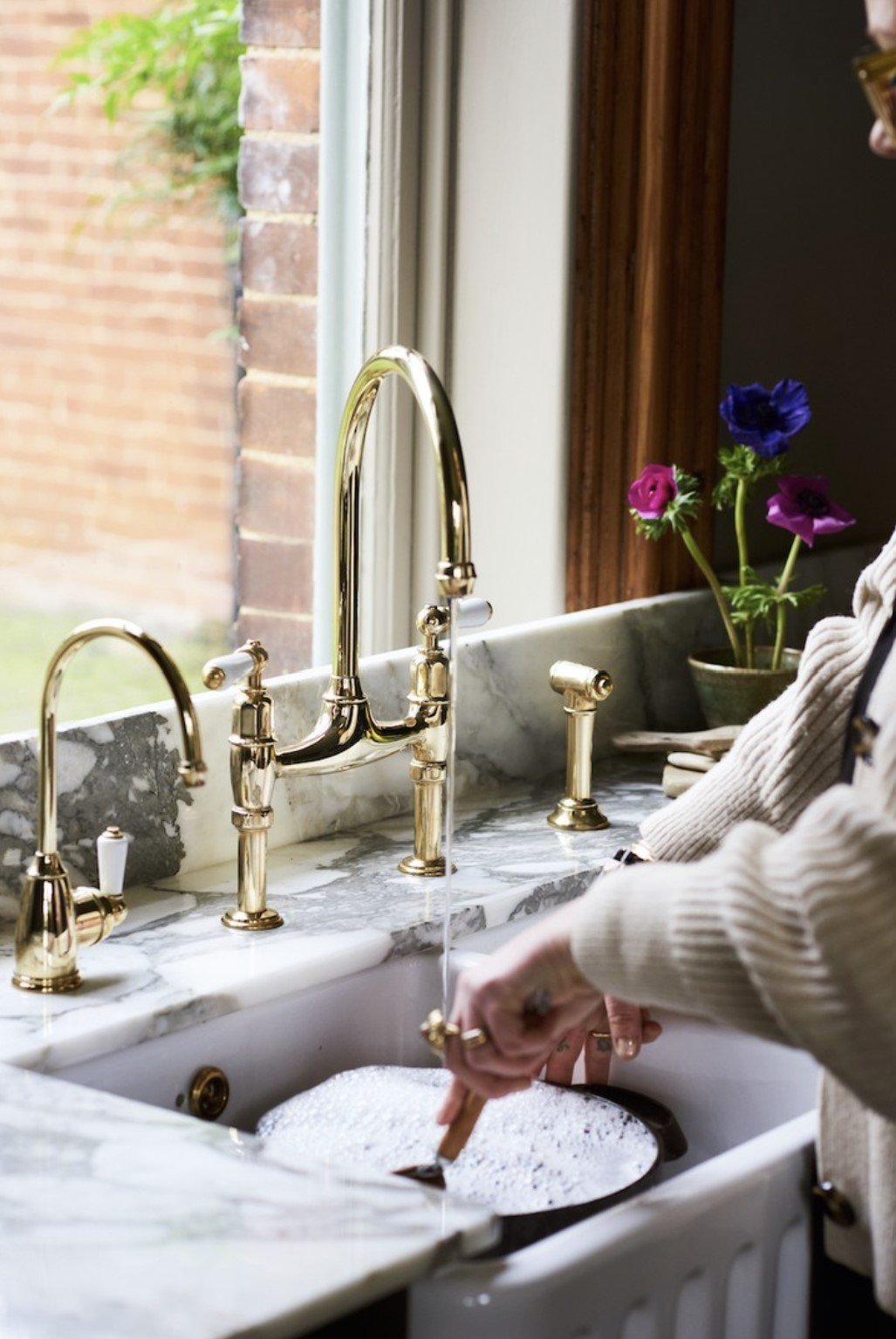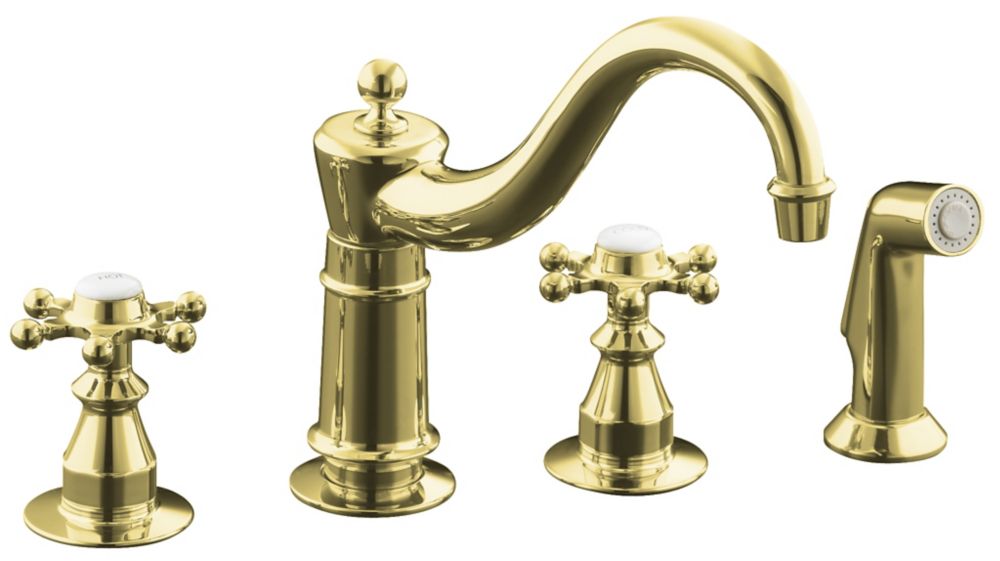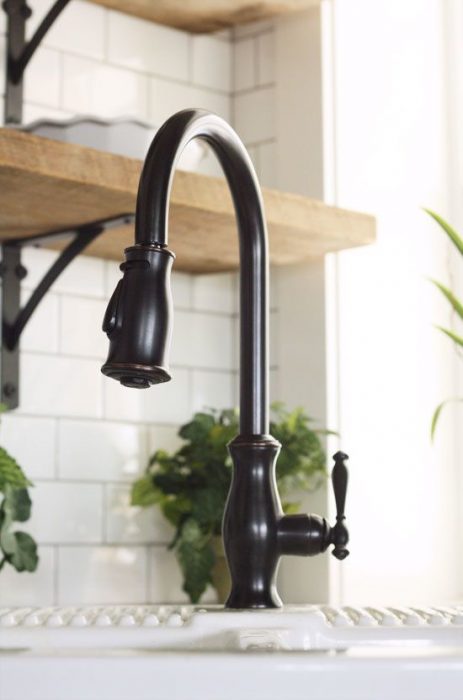The charm of an old-fashioned kitchen faucet is something I’ve always found captivating. There’s a timeless elegance to its design, blending nostalgia with functionality. When I think about these faucets, I imagine a cozy kitchen bathed in warm light, with vintage accents that make the space feel welcoming and personal. Old-fashioned faucets often have intricate designs, like curved spouts, cross-shaped handles, and polished finishes that harken back to a simpler time. While modern fixtures might prioritize sleek minimalism, old-fashioned styles offer a balance of character and utility that feels more like an art piece than just a functional tool.
One of the reasons people gravitate toward old-fashioned kitchen faucets is their aesthetic appeal. They can instantly transform a kitchen, giving it a classic, retro, or farmhouse vibe. Whether paired with a traditional farmhouse sink or a modern granite countertop, these faucets add personality to any setting. The range of finishes available, from gleaming polished brass to rustic oil-rubbed bronze, makes it easy to find one that complements your decor. These faucets aren’t just about looks—they also tell a story, evoking the charm of a bygone era.

I’ve noticed that many homeowners are rediscovering the joy of incorporating vintage or vintage-inspired elements into their kitchens. An old-fashioned faucet might seem like a small detail, but it can serve as a focal point, drawing attention to its unique design. When paired with other retro features like open shelving, subway tiles, or antique cabinet hardware, the faucet helps to create a cohesive, timeless look. These design choices show a preference for character and craftsmanship over fleeting trends, which is something I deeply admire.
While they are undeniably beautiful, old-fashioned faucets aren’t just about aesthetics. Many of them are built to last, with durable materials and solid construction that can withstand years of use. Unlike some modern options, which may sacrifice quality for cost-efficiency, old-fashioned faucets often prioritize functionality and longevity. Even the design of the handles—be it cross-shaped or lever-style—offers a tactile experience that’s both satisfying and practical. The craftsmanship behind these fixtures ensures they remain reliable while providing a touch of nostalgia.

If you’re considering adding an old-fashioned faucet to your kitchen, there are several factors to think about. First, you’ll want to determine whether you’re looking for a genuine vintage faucet or a reproduction. Genuine vintage faucets have an unmatched authenticity, but they may require restoration or retrofitting to meet modern plumbing standards. Reproductions, on the other hand, offer the charm of vintage designs with the added benefit of contemporary functionality and compatibility with modern systems.
It’s also important to consider the type of finish and how it will age over time. Polished chrome or nickel tends to maintain its shine with regular cleaning, while finishes like brass or bronze develop a patina that adds character as they age. I’ve always loved the way an aged brass faucet tells its own story over the years, reflecting the passage of time while still serving its purpose. The finish you choose can greatly influence the overall look and feel of your kitchen.

Installing an old-fashioned kitchen faucet isn’t just about upgrading your sink area; it’s about creating a space that feels personal and timeless. These faucets often pair well with other design elements, such as apron-front sinks, vintage dish racks, or even hand-painted tiles. They bring a sense of warmth and history to the kitchen, making it feel less like a workspace and more like the heart of the home. For me, this sense of connection and tradition is what makes them so special.
Another benefit of old-fashioned kitchen faucets is their versatility. Despite their vintage appearance, many models are designed to work seamlessly in a variety of kitchen styles. Whether your kitchen is rustic and cozy or sleek and modern, there’s likely an old-fashioned faucet that can blend in beautifully. This adaptability is a testament to their timeless design, which transcends specific trends and remains relevant year after year.
However, it’s essential to balance form and function. Some old-fashioned faucets come with modern features like pull-down sprayers or single-handle operation, which can be a boon for convenience. These updates make it easier to enjoy the vintage aesthetic without sacrificing practicality. For those who value sustainability, many manufacturers also offer water-saving options, ensuring you can reduce your environmental footprint without compromising on style.

Maintaining an old-fashioned kitchen faucet is relatively straightforward, but it does require some care. Regular cleaning with gentle, non-abrasive cleaners will help preserve the finish and prevent buildup. For older, genuine vintage faucets, occasional inspections and maintenance may be necessary to keep them in good working condition. I’ve found that taking the time to care for these fixtures not only prolongs their lifespan but also allows me to appreciate their craftsmanship even more.
Cost can be a consideration when choosing an old-fashioned kitchen faucet, as genuine vintage pieces or high-quality reproductions may come with a higher price tag. However, I believe the investment is worthwhile for the character and durability they bring. If budget is a concern, there are plenty of affordable options that capture the vintage look without breaking the bank. Shopping at antique stores, salvage yards, or even online marketplaces can yield unique finds that fit within your price range.
When it comes to installation, it’s worth consulting a professional plumber, especially if you’re working with a vintage faucet that may need special fittings. Proper installation ensures that the faucet functions correctly and prevents potential leaks or damage. While DIY installations are tempting, I’ve learned that investing in professional help can save time and headaches in the long run.

Old-fashioned faucets also have a way of making everyday tasks feel more enjoyable. Washing dishes, filling pots, or even just rinsing vegetables becomes a more intentional experience when you’re using a fixture that feels like a piece of history. For me, these small moments of appreciation make a big difference, turning routine chores into opportunities to connect with the space around me.
I’ve also noticed that old-fashioned kitchen faucets often spark conversations. Guests are drawn to their distinctive designs and often comment on how they enhance the overall look of the kitchen. It’s a small detail that can leave a lasting impression, showing that you’ve put thought into creating a space that’s both functional and beautiful.
In a world where everything seems to be moving toward automation and minimalism, something is grounding about incorporating old-fashioned elements into our homes. These faucets remind us to slow down and appreciate the beauty of craftsmanship and design. They bring a sense of warmth and nostalgia to the kitchen, making it a place where memories are made and shared.
If you’re on the fence about whether an old-fashioned kitchen faucet is right for you, I encourage you to consider the emotional and aesthetic value it can bring. These fixtures are more than just functional tools—they’re a celebration of tradition and artistry. Choosing one for your kitchen is like adding a piece of history to your home, creating a space that feels both timeless and uniquely yours.

Common Mistakes to Avoid
One common mistake people make when selecting an old-fashioned kitchen faucet is prioritizing appearance over functionality. While the design is important, it’s equally vital to ensure the faucet is compatible with your sink and plumbing system. Failing to check dimensions, water pressure requirements, or installation methods can lead to unnecessary frustration or additional costs.
Another pitfall is neglecting the finish. Some finishes, like polished brass, require regular upkeep to maintain their shine, while others, like oil-rubbed bronze, develop a patina over time. If you’re not prepared for the maintenance or aging process, you might find yourself disappointed. It’s crucial to choose a finish that aligns with both your aesthetic preferences and lifestyle.
Some people also overlook the importance of quality. Opting for a cheaper, lower-quality faucet might save money upfront but could lead to issues like leaks, corrosion, or mechanical failure down the line. Investing in a reputable brand or a well-made reproduction ensures durability and long-term satisfaction.
Another mistake is attempting a DIY installation without the necessary knowledge or tools. While it might seem straightforward, improper installation can cause leaks, damage to the faucet, or even plumbing issues. Hiring a professional can save you from costly repairs and ensure the job is done correctly.
Lastly, failing to consider modern features is a missed opportunity. Many old-fashioned faucets come with updated functionalities, like pull-down sprayers or water-saving mechanisms. Ignoring these options might limit the faucet’s practicality, so it’s worth exploring models that offer the best of both worlds.

Why should I choose an old-fashioned kitchen faucet over a modern one?
An old-fashioned kitchen faucet offers timeless charm and character that modern designs often lack. These faucets add a sense of warmth and nostalgia to your kitchen, making it feel more personal and inviting. Many models also combine vintage aesthetics with modern features, giving you the best of both worlds.
Are old-fashioned kitchen faucets compatible with modern sinks?
Yes, most old-fashioned faucets are designed to fit standard modern sinks. However, it’s important to check the dimensions and specifications of both the faucet and the sink to ensure compatibility. For vintage faucets, retrofitting may be required to match modern plumbing.
How do I maintain the finish on an old-fashioned faucet?
Regular cleaning with a soft cloth and non-abrasive cleaner is key to maintaining the finish. Avoid harsh chemicals or scrubbers that could damage the surface. For finishes like brass or bronze, allowing a natural patina to develop can enhance their vintage appeal.

Where can I find genuine vintage kitchen faucets?
Antique stores, salvage yards, and online marketplaces are great places to search for genuine vintage faucets. Keep in mind that these may require restoration or retrofitting to meet modern plumbing standards.
Do old-fashioned faucets come with modern features?
Yes, many reproductions of old-fashioned faucets include modern features like pull-down sprayers, single-handle operation, and water-saving technologies. These updates make them more practical for everyday use while maintaining their classic design.
Are old-fashioned kitchen faucets expensive?
The cost varies widely depending on the brand, material, and whether it’s a genuine vintage piece or a reproduction. While some high-end models can be pricey, there are plenty of affordable options available that capture the vintage look without compromising quality.

Related Posts:
- Delta Pre Rinse Kitchen Faucet
- Moen Brantford Kitchen Faucet Motionsense
- Moen Kitchen Faucet Low Pressure
- Delta Kitchen Faucet Diverter Valve Replacement
- Delta Two Handle Kitchen Faucet Diverter Repair
- How Much To Install New Kitchen Faucet
- Oak Brook Kitchen Faucet Repair
- Fairbury Single Handle Pull Down Sprayer Kitchen Faucet
- Delta Linden Kitchen Faucet Stainless
- Vigo Chrome Pull Down Spray Kitchen Faucet